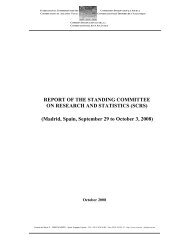REPORT OF THE 2008 ICCAT WORKING GROUP ON STOCK ...
REPORT OF THE 2008 ICCAT WORKING GROUP ON STOCK ...
REPORT OF THE 2008 ICCAT WORKING GROUP ON STOCK ...
You also want an ePaper? Increase the reach of your titles
YUMPU automatically turns print PDFs into web optimized ePapers that Google loves.
WG Stock Assessment Methods – Madrid <strong>2008</strong>total catch/carrying capacity = 2.86 in 1982 vs. 5.57 in 1993. This index remains at 6.32 in 2006 even if this fleetis becoming older (Figure 15) Such an increase in efficiency of the purse seiners (i.e., not directly related tovessel hold volume) may be due in part to the massive use of FADs fishing operations in the eastern Atlanticand/or the introduction of new fishing technology on board. Although this effect is less pronounced for baitboats,it must be stressed that the baitboat total catch remained stable over the period when carrying capacity decreasedslowly. These patterns are reinforced by the comparative analysis with the total mortality series. In spite of purseseine carrying capacity decreasing in the recent years, the apparent total mortality of yellowfin and bigeyeremained at high values. It has been noticed however that the potential relationship of causality between thecarrying capacity of surface fisheries and Z may be altered by the fact that both species are caught also by thelongline fishery. In contrast, the decrease of Z observed for skipjack (a species targeted only by the surfacefisheries) since the mid nineties is in agreement with the decreasing trend in carrying capacity observed for thesame period of time. It is unclear, however, whether this pattern is due to the reduction of the nominal fishingeffort or results from the application of the moratorium on FADs fishing adopted by the EC purse seiners since1997.In addition, the Working Group analyzed the changes over time of the average catch per vessel for three sizecategory of EC purse seiners (only vessels fishing for more than 10 years and with a minimum catch of 800t/yearwere considered). Results from this analysis indicated that the average catch per vessel has been stabilized forthe smallest and the largest size class of purse seiners (< 1000m 3 carrying capacity and >1500m 3 carryingcapacity, respectively) since the early 1990s at about 2900 t/year and 5600 t/year, respectively (Figure 16). Inopposite, the performance of the intermediate size class (1000-1500m 3 carrying capacity) depicted a slow butcontinuous increasing trend, and then sharply increased after 2001.During the Methods Working Group held in 2007, a comparative analysis of the changes over time of thecarrying capacity of purse seiners operating in other oceans was conducted. From this study different patternswere observed:• In the Indian Ocean, at the beginning of the purse seine fishery, carrying capacity increased rapidly between1984 and 1993, and remained nearly constant thereafter. It should be noted that the capacity of the dozensupply vessels operating in Indian Ocean is not accounted for because they do not catch tuna, even if theirassistance greatly increased the fishing power of the PS fleet active on FADs, as indicated by a steady increaseof total catches during recent years (1993-2005) when carrying capacity remained nearly constant (see Figure17).• In the eastern Pacific, since 1980, carrying capacity of the tropical purse seine fleet has been always muchhigher than in the other oceans. During the early 1980s the very large capacity produced only low yearlycatches, while catches triplicate in the recent years for a comparable level of capacity.These differences in the observed relationship between yearly catches and carrying capacity are linked with thechanges in the nominal CPUEs observed in each ocean for these purse seine fleets (see Figure 18). The Atlanticnominal CPUEs are low relative to the other oceans and this result can explain why there has been no renewal ofthe purse seine fleet and a steady decline of carrying capacity for purse seine in the Atlantic. In contrast, nominalCPUE in the Indian Ocean has been continually increasing. This feature also explains the renewal of the purseseine fleets in the Indian Ocean (where the average age of the purse seine fleet is 16 years) in contrast to thepurse seine fleet active in the Atlantic Ocean (wherein no new tropical purse seine vessels have been introducedsince 1992) and the fleet now have an overall average age of over 26 years, (see Figure 19). This average age ofthe purse seine fleet and its recent rate of yearly renewal may be important factors when analyzing the dynamicsof the fishing capacity: it would appear for instance that a given carrying capacity of a purse seine fleet will nothave the same efficiency and the same prospects when the fleet has an average age of only six years (the Atlanticfleet in 1980) or when there is a senescent fleet with an average age over 26 years (the Atlantic fleet in 2006);with very uncertain prospects to bring new boats in the Atlantic (due to the increasing costs of purse seinevessels and as the CPUE in the area are relatively low).In conclusion, the comparative analysis of the observed relationship between carrying capacity of the purse seinefleets and their yearly catches show well the high degree of variability between carrying capacity andproduction: (1) as a function of each ocean (each ocean showing a peculiar pattern, probably linked with itsbiological productivity and competition between purse seiners and other gears), and (2) within each ocean, as afunction of the years and period, with a global tendency in all areas to improve the nominal CPUE, due totechnology creep from multiple improvements in the fishing practices of PS, even when the fleets are ageingones. These features are not generally captured in capacity metrics and for that reason, capacity based7
















